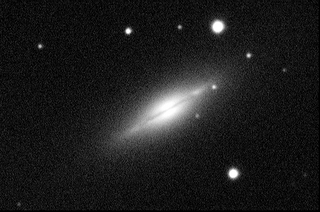Every once in a while in this job you come across something that is totally cool. While compiling a target list for a proposal I'm working on I came across this little baby.
NGC 5866, its an S0 (thats S-zero) galaxy, and as such usually looks pretty dull, especially when you only have one observation in a single filter, like below.

You may notice more than a passing resemblance to my own favourite S0 NGC 3115, check out an image I made of it here (Note this was not made with the HST, it was done on the ground through some poor seeing and thats why by comparison it looks crap).
When you point the HST at NGC 5866 and take images in three different bands you can get this though:

For a really cool zoomable version of this picture, as well as more details on the galaxy get over to here. Try zooming into the strong dust lane, its incredible how fine the detail is.
I'm actually interested in the discs of galaxies like these, you can see the disc just peaking out from behind the dust towards the 5 and 11 O'Clock positions, it's very blue which is very interesting. Now the blueness could just be an artifact of the way the image was made from the different filters used to image the galaxy, so I downloaded the original files from the HST archive and had a bit of a play around, the short story is that the disc probably is blue. But I also found a couple of other observations in different bands (filters) that with a bit more work should let me make an image that reveals a bit more. I'll keep you posted.
As most of the astronomers know, a stellar population that is blue can look like that for one of two reasons, because its made up of young stars, or its made up of very old stars which have very few elements heavier than Helium. Both these cases would be interesting, but my moneys on it being a young stellar population, a metal poor disc just doesn't make that much sense when there is all of that dust around, we'll find out if I get the observing time I want.
I'll explain why its interesting after the proposal deadline. :)
NGC 5866, its an S0 (thats S-zero) galaxy, and as such usually looks pretty dull, especially when you only have one observation in a single filter, like below.

You may notice more than a passing resemblance to my own favourite S0 NGC 3115, check out an image I made of it here (Note this was not made with the HST, it was done on the ground through some poor seeing and thats why by comparison it looks crap).
When you point the HST at NGC 5866 and take images in three different bands you can get this though:

For a really cool zoomable version of this picture, as well as more details on the galaxy get over to here. Try zooming into the strong dust lane, its incredible how fine the detail is.
I'm actually interested in the discs of galaxies like these, you can see the disc just peaking out from behind the dust towards the 5 and 11 O'Clock positions, it's very blue which is very interesting. Now the blueness could just be an artifact of the way the image was made from the different filters used to image the galaxy, so I downloaded the original files from the HST archive and had a bit of a play around, the short story is that the disc probably is blue. But I also found a couple of other observations in different bands (filters) that with a bit more work should let me make an image that reveals a bit more. I'll keep you posted.
As most of the astronomers know, a stellar population that is blue can look like that for one of two reasons, because its made up of young stars, or its made up of very old stars which have very few elements heavier than Helium. Both these cases would be interesting, but my moneys on it being a young stellar population, a metal poor disc just doesn't make that much sense when there is all of that dust around, we'll find out if I get the observing time I want.
I'll explain why its interesting after the proposal deadline. :)


2 comments:
NGC 3115 really is pretty cool. I had never seen that hubble picture before.
high quality replica handbags GMPZ aaa replica bags DGQW replica designer bags GNSBV
Post a Comment